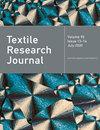Extraction and recognition of breast morphological feature parameters based on machine learning models
IF 1.9
4区 工程技术
Q2 MATERIALS SCIENCE, TEXTILES
引用次数: 0
Abstract
Breast feature parameters could represent breast morphology. It is significant for improving bra fit, and is an important aspect of garment ergonomics. To obtain the important feature parameters that can effectively represent breast morphology, this study proposed a feature parameter extraction method based on the machine learning model. First, the human body point-cloud data of 201 female college students were obtained by a three-dimensional body scanner, and 24 feature parameters related to breast morphology were acquired. Then, the cluster analysis was used to classify breast morphology into four categories: uniform hemisphere, outward expanding circular, converging water drop, and outward expanding hemisphere. Finally, principal component analysis was used to reduce the dimensionality of feature parameters, and the three machine learning models, naive Bayes, support vector machine, and random forest, were utilized to extract the parameters after dimensionality reduction. The results showed that principal component analysis could reduce the dimensions of breast feature parameters to seven main parameters. Based on the above three models, the seven main parameters were further reduced to three important feature parameters. They were sorted sequentially: breast volume, breast surface area, and longitudinal breast cup straight line length, and the Fisher discriminate function was used to distinguish breast morphology. The recognition accuracy based on the three important feature parameters reached 99%, higher than 97.5% for full feature parameters recognition, and 98% for seven feature parameters recognition. It is proved that the three important feature parameters obtained by the machine model are effective in characterizing breast morphology.基于机器学习模型的乳房形态特征参数提取与识别
乳房特征参数可代表乳房形态。这对改善胸罩的合身性意义重大,也是服装人体工程学的一个重要方面。为了获得能有效代表乳房形态的重要特征参数,本研究提出了一种基于机器学习模型的特征参数提取方法。首先,通过三维人体扫描仪获取了 201 名女大学生的人体点云数据,并获取了与乳房形态相关的 24 个特征参数。然后,利用聚类分析将乳房形态分为均匀半球形、外扩圆形、汇聚水滴形和外扩半球形四类。最后,利用主成分分析法降低特征参数的维度,并利用天真贝叶斯、支持向量机和随机森林三种机器学习模型提取降维后的参数。结果表明,主成分分析可以将乳房特征参数的维数减少到七个主要参数。在上述三个模型的基础上,七个主要参数被进一步缩减为三个重要特征参数。它们被依次排序为:乳房体积、乳房表面积和乳杯纵向直线长度,并使用费雪判别函数来区分乳房形态。基于三个重要特征参数的识别准确率达到 99%,高于全特征参数识别准确率的 97.5%和七个特征参数识别准确率的 98%。结果证明,机器模型得到的三个重要特征参数能有效地表征乳房形态。
本文章由计算机程序翻译,如有差异,请以英文原文为准。
求助全文
约1分钟内获得全文
求助全文
来源期刊

Textile Research Journal
工程技术-材料科学:纺织
CiteScore
4.00
自引率
21.70%
发文量
309
审稿时长
1.5 months
期刊介绍:
The Textile Research Journal is the leading peer reviewed Journal for textile research. It is devoted to the dissemination of fundamental, theoretical and applied scientific knowledge in materials, chemistry, manufacture and system sciences related to fibers, fibrous assemblies and textiles. The Journal serves authors and subscribers worldwide, and it is selective in accepting contributions on the basis of merit, novelty and originality.
 求助内容:
求助内容: 应助结果提醒方式:
应助结果提醒方式:


